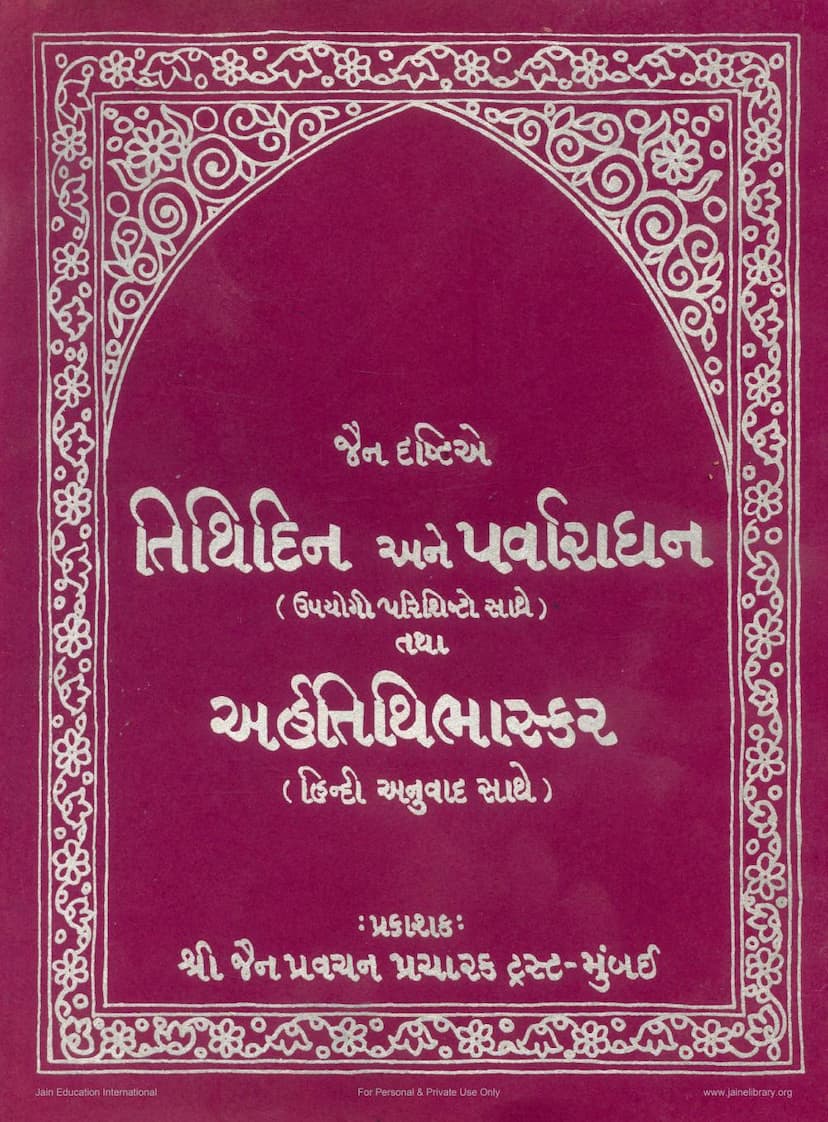Tithidin Ane Parvaradhan Tatha Arhattithibhaskar
Added to library: September 2, 2025

Summary
This Jain text, titled "Tithidin ane Parvaradhan tatha Arhattithibhaskar" (meaning "Holy days and Festivals according to Jainism, and the Sun of Arhats' holy days"), published by the Shri Jain Pravachan Pracharak Trust, Mumbai, in 1977 (Vir Samvat 2503, Vikram Samvat 2033), addresses a significant theological and practical dispute within the Jain community regarding the determination of holy days (tithis) and the proper observance of festivals (parva). The text is a comprehensive record of a arbitration process that took place between two prominent Jain Acharyas: Acharya Shri Sagaranand Surishwarji Maharaj and Acharya Shri Vijayaramchandra Surishwarji Maharaj.
The core issue revolves around the correct interpretation and application of Jain astronomical principles and traditions (Tippana/Panchanga) for determining the exact dates of holy days, especially when traditional calendars (Panchanga) show discrepancies like kshaya (merging) or vrddhi (extension) of tithis, or the presence of intercalary months. The dispute highlights differing views on how to resolve these calendar variations to ensure the proper observance of festivals and religious duties.
Key aspects of the text include:
-
The Arbitration Process: The book documents an arbitration initiated by Shri Kasturbhai Lalbhai, a respected figure in the Jain community. The arbitration aimed to settle the long-standing dispute between the two Acharyas, who represented differing interpretations of Jain calendar practices. The process involved written submissions from both sides, oral arguments, and a final award by the arbitrator, Dr. P. L. Vaidya.
-
Differing Interpretations:
- Acharya Sagarananda Suri's Stance: His argument, supported by numerous textual references (though his interpretation and selection of texts are challenged), emphasizes the principle of Jita-vyavahara (established practice) and suggests that in cases of kshaya (merging) of a parva tithi (holy day), the preceding apara (non-holy) tithi should be considered, and in cases of vrddhi (extension), the preceding apara tithi should be treated as extended. He also argues that kalyaNak tithis (holy days related to the lives of Tirthankaras) are of a different category and may have different rules, and questions the validity of popular Panchangas while advocating for a Jain Tippana, acknowledging that the latter is now lost and its reconstruction is not feasible. He appears to rely on interpretations that deviate from the standard understanding of Jain scriptures to support his views.
- Acharya Vijayaramchandra Suri's Stance: He advocates for adherence to the commonly accepted popular Panchanga (like the Chandamshuchandu Panchanga). He emphasizes that in cases of kshaya or vrddhi of tithis, the principles of Umasvati's Rule (क्षये पूर्वा तिथिः कार्या, वृद्धौ कार्या तथोत्तरा – "In case of ksaya, the preceding tithi should be followed; in case of vrddhi, the succeeding tithi should be followed") should be applied strictly. He argues that Umasvati's Rule is universally applicable and that Acharya Sagarananda Suri's interpretations are not supported by the Shastras or long-established practices. He highlights the importance of audayiki tithi (the tithi prevailing at sunrise) for religious observances and criticizes the idea of shifting dates or regarding parva tithis as separate from their traditional observance days.
-
The Arbitrator's (Dr. P. L. Vaidya) Award: Dr. Vaidya, after careful examination of the arguments, Shastric evidence, and oral testimonies, concluded that:
- A Siddhanta (Jain) Tippana, based entirely on Jain astronomical data, is currently not in use and its reconstruction is not feasible due to lost or defective data.
- The popular Laukika (secular) Panchanga, specifically the Chandamshuchandu Panchanga of Jodhpur, is currently in use and accepted by the Jain Sangha for both secular and religious purposes.
- This Laukika Panchanga contains kshaya and vrddhi of tithis and intercalary months.
- The adjustment of these calendar variations should be governed by Umasvati's Rule: "In case of ksaya, the preceding tithi should be adopted; in case of vrddhi, the succeeding tithi should be adopted."
- This rule is of universal application to all tithis, holy or otherwise.
- The specific application is: Chaturdashi for Paksika and Chaturmasika Pratikramana, and Chaturthi in the bright half of Bhadrapada for Samvatsari.
- The arbitrator noted Acharya Sagarananda Suri's interpretation of Umasvati's Rule as invalid and unsupported by Jain Shastras or established practice. He pointed out contradictions in Sagarananda Suri's arguments and the alleged lack of evidence for the practices attributed to the Devasura sect.
- The arbitrator emphasized the importance of adhering to the established practices and the need to resolve disputes amicably for the unity of the Jain Sangha.
-
Supporting Documents and Critiques: The book includes critical analyses of the arguments presented by Acharya Sagarananda Suri. It highlights alleged misinterpretations of scriptures, selective quoting of texts, and the creation of "fabricated evidence" to support his viewpoint. The text also includes photocopies of manuscripts and letters, purportedly supporting the traditional interpretation and refuting Acharya Sagarananda Suri's claims.
In essence, the book is a detailed historical and theological document capturing a significant debate within Jainism regarding the precise observance of religious calendars, emphasizing the importance of adhering to scriptural interpretations and established practices while highlighting the challenges posed by differing interpretations and the need for consensus in religious matters. The award by Dr. P. L. Vaidya leans towards the interpretation that aligns with established practices and the principle of following the commonly accepted popular Panchanga when Siddhanta Tippana is unavailable, while upholding the general principle of observing religious rites based on Umasvati's rule. The text also serves as a critical examination of the arguments presented, particularly challenging the interpretations and claims made by Acharya Sagarananda Suri.